Just days before Istanbul’s elections were scheduled on March 31, Turkish President Recep Tayyip Erdoğan declared that the 1500-year-old Hagia Sophia, now a museum, should be converted to a mosque.
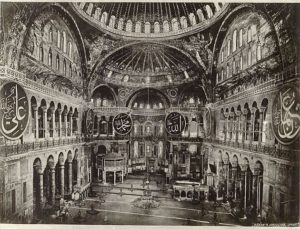
Hagia Sophia, Istanbul Photo: Sébah & Joaillier. Wikimedia Commons.
Hagia Sophia is a Byzantine architectural wonder. Constructed in 537 CE on the orders of the Emperor Justinian I, it served as Constantinople’s Eastern Orthodox cathedral until the city was conquered by the Turkic ruler Mehmet II in the mid 15th century. At Mehmet’s orders, the cathedral was converted to a mosque and the four minarets that surround the giant dome were added. Hagia Sophia served as the imperial mosque for Ottoman rulers from that time until the overthrow of their empire. Mustafa Kemal Ataturk, the founder of modern Turkey, converted the building to a secular museum in 1935 after he took power.
Hagia Sophia is one of the best-known UNESCO World Monuments, and the second most popular museum in Turkey, drawing over three million visitors each year.
Turkish Law and Agreements on Monuments

Photo: Mark Ahsman, Dec 2013, Wikimedia Commons
Erdoğan’s call for turning Hagia Sophia into a mosque appears to contradict multiple domestic laws and international undertakings by the government of Turkey. The 1906 Fourth Antiquities Code and 1926 Turkish Civil Code Law No. 1710, protected monuments as state properties, and established parameters for protection of historic buildings such as Hagia Sophia for most of the 20th century. However, by 1983, the management system for cultural properties under these laws was too antiquated to deal with the increasing number of historical sites. That year, Law No. 2863 regarding the Protection of the Cultural and Natural Assets established both a Superior Counsel and Regional Counsels for the Protection of Cultural and Natural Assets. This law places decision-making regarding the physical interference with, use or change of purpose of cultural assets within the scope of the Ministry of Culture and Tourism, which is directed to take advice from related professional institutions, such as museums.
Among other international agreements on cultural heritage, Turkey ratified the 1972 Convention Concerning the Protection of the World Cultural and Natural Heritage on March 16, 1983. This international convention specifically provides for its member countries to nominate World Heritage properties, which include Hagia Sophia. It also created the World Heritage Fund. The Convention states that while respecting national sovereignty, the signers to the Convention recognize that it is the duty of the international community as a whole to co-operate in protecting heritage.
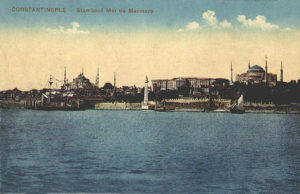
Constantinople from the Sea of Marmara, 1900 postcard, Wikimedia Commons
Section 98 of the 1972 World Cultural and Natural Heritage Convention provides: “Legislative and regulatory measures at national and local levels should assure the survival of the property and its protection against development and change that might negatively impact the outstanding universal value, or the integrity and/or authenticity of the property. States Parties should also assure the full and effective implementation of such measures.”
Turkey is also a signatory to the 1985 Convention of the Architectural Heritage of Europe, where it serves on the steering committee for Culture, Heritage, and Landscape.
In response to Erdogan’s statements, UNESCO announced that the Turkish government could not make the change, saying that Turkey was bound by its commitments to the World Heritage Committee, which must approve changes of use and status of World Heritage Monuments. Erdoğan is doubtless well aware that in September 2018, just seven months before his March announcement, Turkey’s Constitutional Court rejected a plea by religious activists to open Hagia Sophia for Islamic prayer on “noncompetence” grounds.
Using Hagia Sophia for Political Purposes
This is not the first time that Erdoğan has suggested that the former Greek Orthodox patriarchal cathedral should be restored to the religious role it held during the Ottoman Empire. During a 2013 election, Erdoğan, then Turkey’s Prime Minister, attempted to make Hagia Sofia’s conversion both a religious and nationalist issue in his campaign. A similar campaign in 2014 in Istanbul saw protests organized by Erdoğan’s Justice and Development Party (AKP) party demanding Hagia Sophia’s conversion.
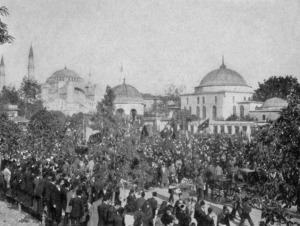
Demonstration in the Hippodrome , circa 1912 -3, Harry Griswold Dwight (1915) Constantinople, Old and New, New York & London: Harper Brothers.
Some Turkish commentators have seen Erdoğan’s most recent statements as a blatant attempt to gain votes for the religiously conservative AKP party. However self-serving the call to convert Hagia Sofia to a mosque appears, Erdoğan has used the issue in the past, both to win domestic support (for example, Erdoğan prayed there publicly last year when in political trouble) and as a counterploy in international politics. The most recent call to convert Hagia Sophia came soon after President Donald Trump’s announcement that the U.S. would recognize Jerusalem as Israel’s capital and Israeli sovereignty over the Golan Heights. Erdoğan has relentlessly tied his latest public pronouncements to the Christchurch, New Zealand shooter’s stated intention of “removing the minarets of the Hagia Sophia.” In fact, Erdoğan showed the shooter’s footage from the attack, which most news outlets have refused to make public, at his election rallies.
Erdoğan’s attempts to redirect voters’ focus to religious issues and international crises may simply be an attempt to distract Turkish citizens from the current recession in Turkey, its double-digit inflation, high unemployment, and the devaluation of its currency in 2018.
However, while some say that Erdoğan’s threats to convert Istanbul’s Hagia Sophia should be brushed off as election rhetoric, the Turkish government has already turned two other ancient Orthodox Christian cathedrals into mosques: the Hagia Sophia of Iznik (Nicaea) was changed from a museum to a mosque in 2011, and the Hagia Sophia in Trabzon was converted in 2013.
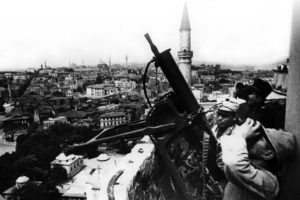
MG08 machine gun on the minaret of the Ayasofya Museum, September 1941, Istanbulpedia, Wikimedia Commons
Erdoğan’s tactics did not appear effective in converting votes – the Justice and Development Party (AKP) lost the March 31, 2019 election in Istanbul and three other major cities. Since then, there have been no further reports that President Erdoğan has spoken of converting Hagia Sophia back to a mosque. There is a strong movement among contemporary Turks, despite personal Muslim piety, to ensure the continuation of a democratic, secular state. These citizens have resisted Erdoğan’s attempts to make use of religious sentiment in party politics by reconsecrating Hagia Sophia as a mosque.
Greek Officials React
The Turkish president has succeeded in angering Greek Foreign Minister George Katrougalos, who stressed Hagia Sophia’s historical importance and role as a symbol of interfaith cooperation. Likewise, in February 2019, Greek Prime Minister Alexis Tsipras visited the Hagia Sophia, calling it “an iconic and disputed landmark in Istanbul which has recently been at the centre of tensions between Athens and Ankara over Muslim activity.” Some commentators noted that the conversion of Hagia Sophia could also jeopardize the Turkish government’s relationship with Moscow, given the rise in Orthodox feeling in Russia today.
Istanbul’s Orthodox Greek Population Worried
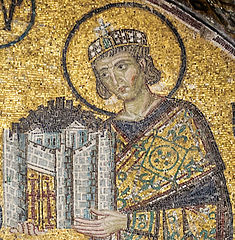
Emperor Constantine I, presenting a model of the Constantinople basilica Hagia Sophia to the Blessed Virgin Mary. Detail of the southwestern entrance mosaic in Hagia Sophia (Istanbul, Turkey). January 2013, Photo: Myrabella, Wikimedia Commons
The collapse of the Ottoman Empire and the Greco-Turkish War resulted in massive deportations and exchanges of population between Greece and Turkey. While Greeks in Istanbul were largely exempted from the resettlement of over a million people in 1923, a 1955 pogrom spurred a massive emigration. It is estimated that fewer than 3000 persons of Greek Orthodox heritage remain in Turkey. The community is both aging and shrinking and has no voice in the country’s politics. Its religious head, the Ecumenical Patriarch and Archbishop of Constantinople is one of the Eastern Orthodox bishops of the eastern autocephalous churches. The current patriarch, Bartholomew I has served since 1991. Turkey requires that the Patriarchate be held by a Turkish-born citizen, and only a small number of individuals meet that criteria today. There have been numerous instances of state appropriation of church property including monasteries and schools left empty, but the Turkish government has also made some conciliatory gestures to the church, including allowing participation by bishops from outside Turkey in church convocations.
Concerns over Preservation
International observers are already concerned about the security and safety of Hagia Sophia, and about marshaling funds from international organizations for its upkeep. For years, preservation experts have called for significant investment in restoration of the unique building. The World Monuments fund and other donors have spent more than a million dollars in repairs, but these efforts amount to little in comparison to the enormous size and scale of the building and its delicate, ancient painted and mosaic decoration. According to professor Zeynep Ahunbay, “We need a permanent restoration staff, conservators for the mosaics, frescoes and masonry, and we need to have them continuously at work.”
Ten years ago, Verkin Arioba, founder of the Historical Heritage Protection Foundation of Turkey, told Smithsonian Magazine, “At this point, we don’t even know how much consolidation and restoration the building needs, much less how much it would cost,” Arioba continued, “First we need to assess how much damage has been done to the building. Then we’ll at least know what must be done.”
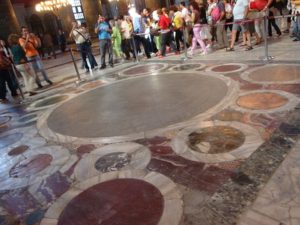
Photo: Mayatomo, Sept 2009, Wikimedia Commons
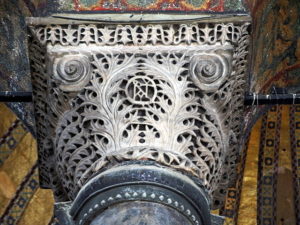
Photo: Mark Ahsman, Dec 2013, Wikimedia Commons
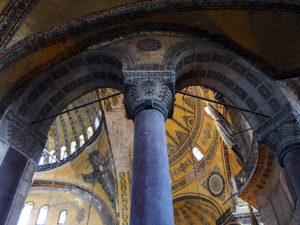
Photo: Mark Ahsman, Dec 2013, Wikimedia Commons
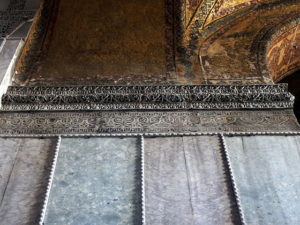
Photo: Mark Ahsman, Dec 2013, Wikimedia Commons
Hagia Sophia. The Eastern Orthodox Cathedral of Hagia Sophia is the third church since 360 CE to occupy the site; the first two were burned in riots. The Byzantine Emperor Justinian I ordered the cathedral built in 532; it was completed in just under six years. It remained an Eastern Orthodox Cathedral until 1453, except from 1204-1261 when Constantinople was captured during the fourth crusade and Hagia Sophia was reconsecrated as a Catholic cathedral. Along with other graffiti inscribed in its walls over the centuries, there are at least two sets of Viking runes in Hagia Sophia that are believed to be carved by Viking traders or mercenaries around the 9th century AD. Vikings also served as members of the Varangian Guard, a group of elite soldiers who were bodyguards for the Byzantine Emperors. Ottoman forces, under Sultan Mehmet II, captured Constantinople in 1453. Mehmet then ordered the Hagia Sophia converted to a mosque. When the Republic of Turkey was founded in 1923, its first president was Mustafa Kemal Atatürk, who instituted widespread reforms to create a secular country. Under Ataturk’s orders, a number of mosques that were formerly Christian cathedrals were converted into museums; the Hagia Sophia in Istanbul was made into a museum in 1935.
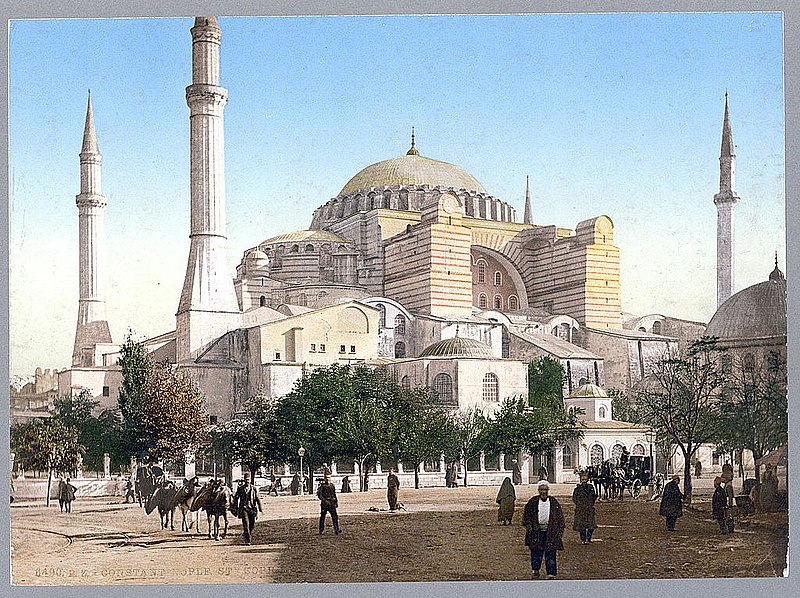 Ayasofya Müzesi,
1890-1900. Library of Congress Prints and Photographs Division Washington, D.C
Ayasofya Müzesi,
1890-1900. Library of Congress Prints and Photographs Division Washington, D.C 

